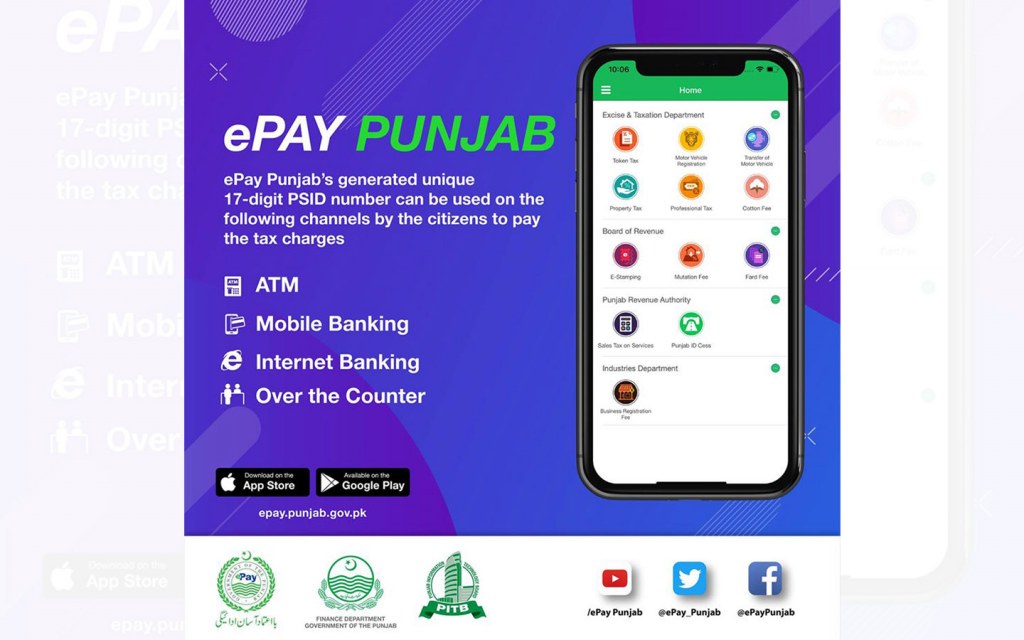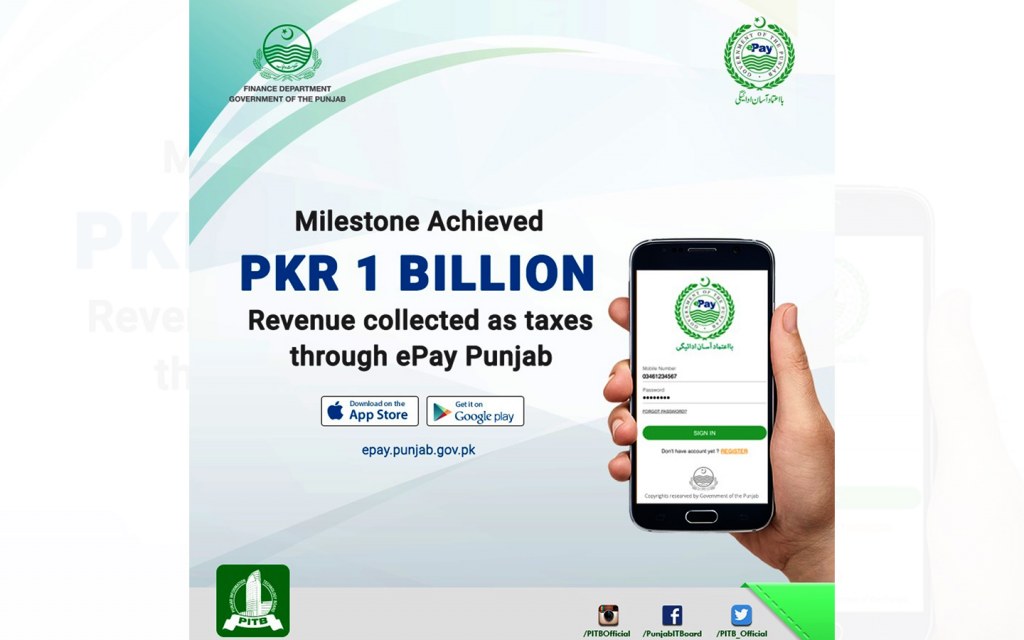Home » Laws & Taxes » A Guide to the ePay Punjab App
IN THIS POST:
– About the ePay Punjab App
– Payment Methods
– Types of Taxes
– How Does the App Work?
– Where to Pay the Dues?
– Impact of the ePay Punjab App
– Reasons to Use the App
Need to pay your taxes but hate the hassle of visiting different government offices around town for the payment? Well, the Punjab Finance Department and the Punjab Information Technology Board (PITB) came together to launch the ePay Punjab app, which allows you to pay your taxes conveniently using this mobile application. Check out this detailed guide for the ePay Punjab app so that you can stay on track with your taxation payments across five departments.
What is the ePay Punjab App?
Launched in October 2019 by the Punjab government as a joint development of the Punjab Finance Department and the PITB, the ePay app is an Android and iOS-friendly mobile application that can facilitate the general public in making business-to-government (B2G) and public-to-government (P2G) payments. PITB’s ePay app also has a web-based application that can be opened on your laptops or tablets.
The aim of launching the app is to make it easier for the government to collect revenue in the form of taxes via an easy solution. The app shows how Pakistan and its government are rapidly moving towards the incorporation of financial technology (fintech) into its workings, with Pakistan’s first digital tax aggregator.
Connecting all registered banks and the State Bank of Pakistan (SBP) using 1-link connectivity, the app will allow people to pay 14 of their taxes via three payment methods or Alternative Delivery Channels (ADCs). With the use of the ePay Punjab app, people will no longer need to physically visit government offices and wait in long queues to pay their dues to the government.
How Does It Work?
ePay Punjab | DemoePay Punjab – How to use the app to pay your taxes online.Visit: epay.punjab.gov.pkDownload NOW!Android: bit.ly/2P90chOiOS: apple.co/35SQXbj
Posted by Punjab Information Technology Board (PITB) on Friday, February 7, 2020
We’ll now focus this guide for the ePay Punjab app towards the usage of the app, the available payment methods, and details on the different taxes that you can conveniently pay using PITB’s ePay app.
What Modes of Payments Are Available?

[Credits: Facebook/E-Pay Punjab]
ePay Punjab offers three distinct modes of payment as Alternative Delivery Channels:
- Mobile Banking
- Internet Banking
- ATMs
You also have the option of using Over-the-Counter (OTC) banking transactions to pay your dues personally by visiting your nearest bank branch.
Which Taxes Can Be Paid Using the ePay App?
So far, you can pay your taxes digitally for about 6 different departments in Punjab, including the Excise and Taxation Department, with a total of 14 taxes being linked to the app. The complete list is given below:
Department 1: Excise & Taxation
Taxes available:
- Token Tax for Vehicle: An annual tax that is paid by all vehicle owners
- Motor Vehicle Registration: A one-time fee that is paid at the time of purchasing a new vehicle
- Vehicle Transfer: A fee that is paid when you transfer ownership of a vehicle
- Property Tax: An annual tax that is paid by all property owners in the urban areas
- Professional Tax: Taxes that are paid on a yearly basis by a working individual based on their professional activities
- Cotton Fee: A fee that is paid when raw cotton is brought to a ginning factory to separate the cotton fibres
Department 2: Board of Revenue (BOR)
Taxes available:
- e-Stamping: The payment of stamp duties for judicial, non-judicial, registration, Capital Value Tax (CVT), and comparison fee
- Mutation Fee: A fee that is paid by the buyer when a property is transferred to a new owner
- Fard Fee: A fee that is paid by the new owner of a property for the generation and issuance of a property ownership document
Department 3: Punjab Revenue Authority (PRA)
Taxes available:
- Sales Tax on Services: The taxes which are levied on all service-oriented businesses in Punjab
- Punjab Infrastructural Development Cess: The tax which is collected on the transportation of goods that are produced, manufactured, or consumed in Punjab, as well as those which are imported into or exported out of the province
Department 4: Industries
Taxes available:
- Business Registration Fee: A fee that is paid by an owner to register their business
Department 5: Transport Department of Punjab
Taxes available:
- Route Permit: A fee that is paid by the owners of commercial vehicles when they seek permission to run their vehicles on specific inter and intra-city routes
Department 6: Punjab Police
Taxes available:
- Traffic Challan: A fine paid by all violators of traffic rules
How to Pay Your Taxes Digitally?
Now, let’s cover how you can use the ePay Punjab app to pay your taxes digitally:
Step 1: Download the App
You can download the ePay Punjab app from the Google Play Store or the App Store, for its Android or iOS version, depending on what’s compatible with your device.
Step 2: Create Your Account
Open the app and enter all the relevant details to create your account on the app. These details include your name, mobile number, email address, and CNIC number.
Step 3: Receive the OTP
An OTP is a One-Time Password that will be issued to you via email and on your mobile phone. You will need the OTP to log in to the app successfully and pay your taxes digitally.
Step 4: Choose the Right Tax
After you log in, choose the right department for the tax you want to pay and select the right type of tax.
Step 5: Add the Relevant Details
As is the case with paying taxes, you will need to provide some personal information with regards to the tax you’re paying so that the app can display your data on the screen, including the tax that you need to pay.
Step 6: Generate Challan
Verify that all of the details are correct and choose the ‘Generate Challan’ button to get your unique 17-digit Payment Slip Identification (PSID) number as well as its expiry date. You’ll also find directions for each of the payment methods on the same screen. You will be notified by the app if your tax has already been paid.
Step 7: Pay Your Dues
Use your nearest ATM, inter Bank Funds Transfer (IBFT), or 1-Link Member bank Branches to pay your taxes using your PSID. Remember that you must pay the due taxes before your PSID expires. Otherwise, you will need to generate a new one using the same process again.
It is important to note that the ePay Punjab app can be used in both English and Urdu using the process given above to generate a challan conveniently.
Where to Pay Your Dues?
Once you have a challan and a PSID in hand, it is important to know which bank branches are connected to this service so that you can pay your taxes without further delays. You can review the table below for your payment options:
| Name of Bank | Mobile Banking | Internet Banking | ATM Payment | OTC Transaction |
| Summit Bank | Yes | Yes | Yes | No |
| Bank Alfalah | Yes | Yes | Yes | No |
| Dubai Islamic Bank | Yes | Yes | No | Yes |
| Sindh Bank | Yes | No | No | No |
| Askari Bank | Yes | Yes | Yes | Yes |
| Habib Metro Bank | Yes | Yes | Yes | Yes |
| Faysal Bank Limited | No | No | Yes | Yes |
| JS Bank | Yes | Yes | Yes | Yes |
| Allied Bank Limited | Yes | Yes | No | Yes |
| NRSP Microfinance Limited | Yes | Yes | Yes | Yes |
| Bank Islami | Yes | Yes | Yes | Yes |
| Samba Bank | Yes | No | Yes | Yes |
| Habib Bank Limited | Yes | Yes | Yes | Yes |
| Bank Of Punjab | Yes | No | Yes | Yes |
| National Bank of Pakistan | Yes | No | No | Yes |
| United Bank Limited | No | Yes | Yes | Yes |
| Bank Al Habib | Yes | Yes | Yes | No |
| Al Baraka Bank | Yes | Yes | Yes | Yes |
| Bank of Khyber | No | No | Yes | Yes |
| Meezan Bank | Yes | Yes | Yes | Yes |
| MCB-IB | Yes | Yes | Yes | Yes |
| Soneri Bank | Yes | Yes | Yes | Yes |
| MCB | Yes | Yes | No | Yes |
| Silk Bank | Yes | Yes | Yes | Yes |
| Standard Chartered Bank | No | No | Yes | Yes |
| FMFB Bank | Yes | No | Yes | Yes |
| Telenor Microfinance Bank | Yes | No | No | No |
| Apna Microfinance Bank | No | No | No | Yes |
| Khushhali Microfinance Bank | No | No | No | Yes |
| SME Bank | No | No | No | Yes |
| First Women Bank Limited | No | No | No | Yes |
| First Microfinance Bank | No | No | No | Yes |
| Citibank | No | No | No | Yes |
| FINCA Microfinance Bank | No | No | No | Yes |
The Success of the ePay Punjab App

[Credits: Facebook/Punjab Information Technology Board (PITB)]
The ePay Punjab App was a huge success for the Punjab government, collecting nearly PKR 500 million in its first 100 days. As of March 2020, more than PKR 1 billion has been collected in taxation revenue by the Punjab government after facilitating the citizens with this app.
The PITB also plans to include a number of other payment channels to the app over time, including Debit/Credit card payments, Mobile Wallets, Direct Debits from Bank Accounts, and payment via TELCO Agent Networks.
Furthermore, Government to Public (G2P) and Government to Business (G2B) payment models might also be added in the future, along with other government-associated payments, such as admission fees for colleges and schools, driving license fee, payments for character certificate and domicile, agriculture income tax, and fees for fitness certificate of commercial vehicles.
Why Choose the ePay Punjab App?
We’ve covered all the essential aspects of using the ePay Punjab app in this guide. Here’s a quick overview of why you should consider it too:
- Added convenience with no physical visits to government offices
- Safe, secure, and easy payment processes
- Easy to download Android, iOS, and web applications
- Transparent procedures
- One-click payments
- Ideal for all B2G and P2G payments
- Valid all over Punjab
- Three different payment channels
- Payment of 14 taxes across 6 departments
- Smart search features to find the right department of taxation
- Nearly PKR 1 billion collected in revenue over 5 months
This wraps up our guide for the ePay Punjab app. We’ll update the post for any new developments. Another innovation in Pakistan’s financial sector is the Tax Asaan app launched by the Federal Board of Revenue (FBR), which enables people to file their tax returns with ease.
Keep reading more posts at Zameen Blog in the meantime and reach us at blog@zameen.com for your suggestions and queries.
*[Cover Image Credits: Facebook/ E-Pay Punjab]



